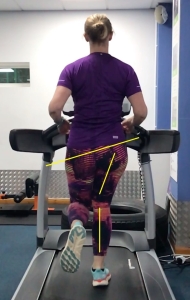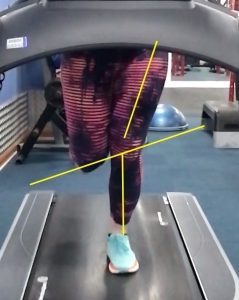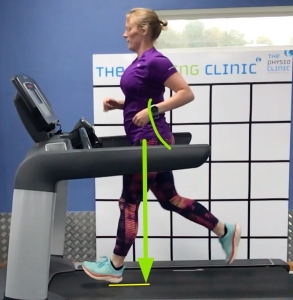The hips and pelvis are a key part of the running analysis, with poor mechanics or weaknesses around this area commonly leading to knee and foot injuries, as well as pain around the hips. Relevant cues and strengthening exercises can be prescribed to create a more efficient running style and reduce injury risk.
The most common hip-related issues that can occur with gait are:
Pelvic Drop
- ‘unilateral drop in height of the pelvis’ usually occurs on the contralateral side of the weakness. For example, if the left side is problematic, the right side will drop during weight-bearing on the left side
- related to core and hip muscle weakness, most commonly the hip abductors (glute med, min) and hip extensor muscles (glute max, hamstring).
- Compromises efficiency, wastes energy, and reduces speed as you spend more time on the ground
- Low back pain can occur due to the compression of the lumbar muscles. This occurs on the opposite side due to continued straining of the soft tissue trying to maintain a level pelvis and keep you balanced
- Ilio-tibial band syndrome (ITBS) is common in movements where the hip shifts laterally, increasing the length of the ITB. The ITB is connected to the glutes which both resist this motion, so if this is constantly being strained the tissue can become irritated. The irritation can present itself with pain at the hip joint or in the lateral knee
Knee Window
- excessive hip internal rotation, hip adduction and knee valgus (knee falling inwards) are all common contributors of running injuries. These can be assessed during a gait analysis looking at the knee window
Hip Extension
- Hip extension produces the power phase which gives the runner propulsion moving them forward
- A lack of hip extension is commonly due to underactive / weak glute max, and can often be because of an anterior pelvic tilt with tight hip flexor muscles
- Poor hip extension when running can increase the risk of hamstring injuries due to the glutes not creating as much of the force, therefore relying more heavily on the hamstrings.
Pelvis Height
- determines how much the body is moving up and down whilst running
- increased vertical movement is often linked to decreased hip extension, often described as runners who “bound”
- decreasing the vertical movement helps to decrease the impact forces on the body and decreases the wasted energy





